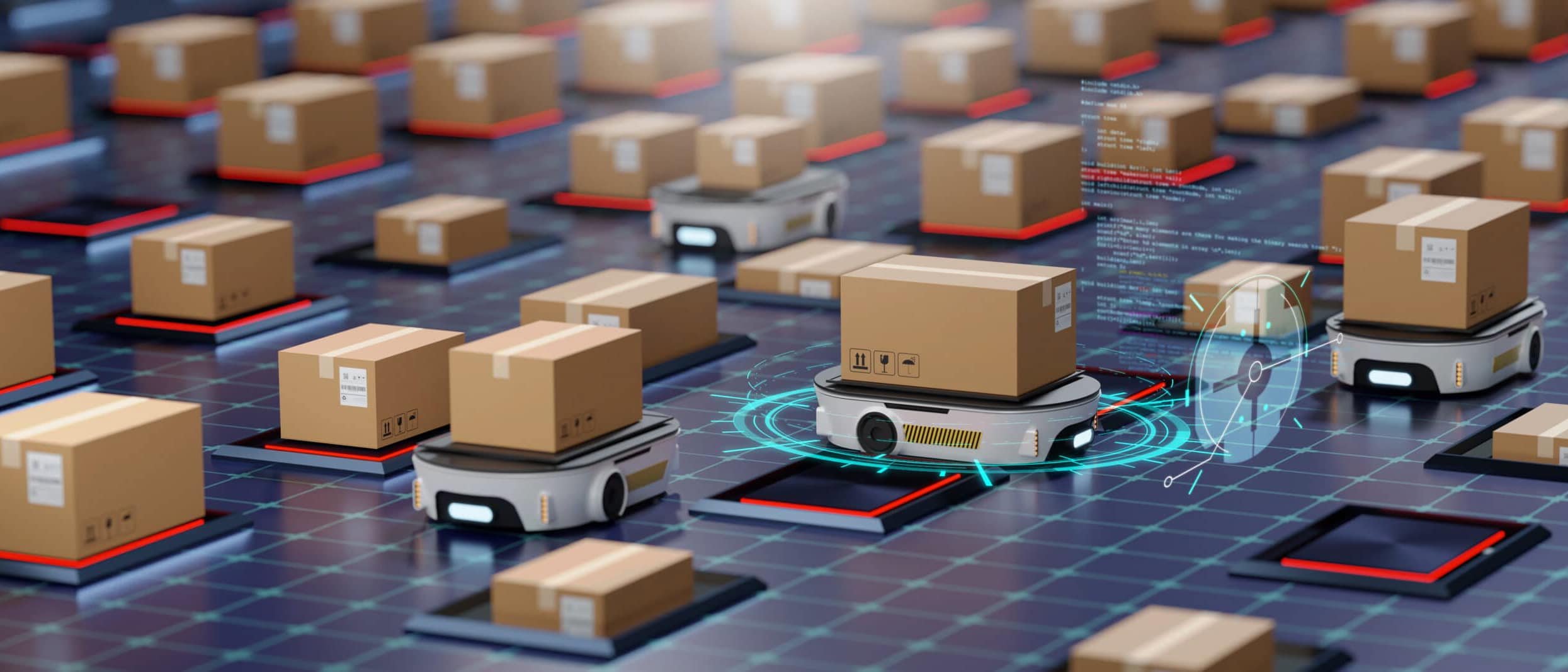Introduction
The pursuit of automation in intralogistics is paramount for many large corporations. This has become increasingly evident over the past 18 months, as COVID-19 has shed light on the need for resilient, flexible, and modular production processes. In the initial months of the pandemic, many workers across the globe were mandated to stay home and socially distance. This resulted in a significant impact on production and supply chains, as goods and commodities were produced in lower quantities – sometimes not at all.
This is where Automated Guided Vehicles (AGVs) become appealing. AGVs are robotic vehicles used to transport materials within a factory or warehouse. There are a variety of different types that serve different functions, including forklifts, trailers, and carts. AGVs provide a number of benefits, such as improving workplace safety, increasing accuracy and productivity, reducing labour costs, and increasing production flexibility.
Human-operated systems and machines may result in accidents and safety hazards, particularly in fast-paced, chaotic production environments. Relying on AGVs to transport materials ensures that workers and AGVs can work safely in tandem. Furthermore, this reliance on AGVs for tedious, time-consuming tasks enables workers to focus on more creative, operational work. An AGV fleet at a production facility can be scaled up or down depending on requirements and AGVs do not require breaks – thereby enabling true flexibility of production.

Challenges
As we alluded to in one of our previous blog posts, interoperability in industrial applications is becoming a fundamental requirement and hurdle that organizations must overcome in order to ensure a flexible, cost-effective solution. However, interoperability is not only a challenge with locating technologies and RTLS – it is a hindrance that plagues AGV fleet management as well.
The market is saturated with AGV manufacturers, however their technologies are often proprietary and only function with their own fleet management software. Industrial sites wanting to expand their fleet by introducing AGVs from different manufacturers would be faced with significant barriers, such as high upfront costs for the installation(s), lack of interoperability between different types of AGVs, and added complexity and inefficiency in managing the different types of AGVs.
Furthermore, managing a fleet of AGVs presents several key challenges, such as routing/navigation and collision control. Having a holistic overview of the entire facility and all the objects moving within it is paramount for safety and efficiency.
VDA 5050
To address these inherent challenges, a standard was conceptualized and developed through collaboration between the German Association of the Automotive Industry (VDA) and the VDMA Materials Handling and Intralogistics Association. This eventually became VDA 5050, a standardized interface for the communication between AGVs and a master control (fleet management software). This standard enables all VDA 5050 compliant AGVs to communicate and interact through a single fleet management software, as opposed to different fleet management software applications being needed for each type of AGV.
The significance of this standard for logisticians and shop floor managers cannot be overstated. While VDA 5050 is a relatively new standard, its adoption and implementation has already sent shockwaves throughout the industry. VDA 5050 allows for interoperability of hardware, greater flexibility, and increased efficiency and simplification – thereby reducing total cost of ownership.
The development of VDA 5050 sought to remedy a fundamental barrier in the industry – lack of interoperability. However, VDA 5050 is only half of the equation.

omlox & the DeepHub®
While the need for interoperability in the AGV sector was gaining more widespread attention, the need for interoperability in locating technologies and solutions was following a similar trajectory. It was becoming increasingly evident that developing a solution with a combination of different locating technologies was difficult and complex, due to high costs and a lack of interoperability and flexibility between hardware and software components.
In 2018, an industry consortium was formed with a group of core partners to build an open locating standard – called omlox. Through omlox, assets may be tracked throughout indoor and outdoor environments by integrating various positioning technologies. An open standard for positioning solutions simplifies logistics and ensures efficiency gains in a variety of industries and verticals. The underlying goal is to make it easier for customers to use hardware and software from different vendors.
This is made possible through our DeepHub – the premier implementation of the omlox standard. The DeepHub is a lightweight middleware that allows for the integration and management of location data from all locating technologies. omlox and the DeepHub provide several key benefits that complement VDA 5050:
- The DeepHub provides access to the movement of not just AGVs, but any and all trackables throughout a facility, such as human-operated machinery and workers. This granular overview of the entire facility allows for true optimization of production processes.
- The DeepHub may be used for georeferencing and reverse georeferencing between local coordinate systems of different AGVs.
- The central and dynamic fencing capabilities of the DeepHub may be used to trigger fence events for speed limit zones, pickup areas, security zones, etc.
- Through the computation of distances and the spatial dimension of movable objects, the DeepHub can prevent collisions between AGVs and everything else – even in conditions that inhibit line of sight.

Conclusion
As Industry 4.0 continues to develop at an exponential rate, the need for standardization in a multitude of facets will continue to unfold. As illustrated above, combining standards opens the door to true flexibility, simplicity, and interoperability between hardware and software components. While VDA 5050 is a standard that enables vendor-independent orchestration of AGVs, omlox is a standard that enables vendor-independent locating of all moving objects. Together, these two form a perfect match to enable holistic traffic management processes in logistics and production.
Get in touch with us today to learn more about omlox and the DeepHub!

Comments are closed.